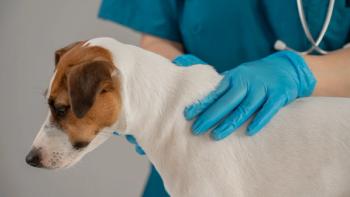
'Why does my dog have dry skin?'
"Why does my dog have dry skin? Didn't I wash off all the shampoo? Am I bathing him too much? Does he need a conditioner?" We have all been asked these questions many times. With the winter months upon us for those in the colder areas of the country, the low humidity often causes humans to have "dry skin". This may be true for our canine patients as well, however dry skin in dogs may be the result of several underlying diseases (Photo 1).
"Why does my dog have dry skin? Didn't I wash off all the shampoo? Am I bathing him too much? Does he need a conditioner?" We have all been asked these questions many times. With the winter months upon us for those in the colder areas of the country, the low humidity often causes humans to have "dry skin". This may be true for our canine patients as well, however dry skin in dogs may be the result of several underlying diseases (Photo 1).
Photo 1: -Dry skin- at an intradermal skin testing site may have several etiologies. Photo 2: Iatrogenic Cushing's disease caused by steroid use in a patient with inflammatory bowel disease. Skin changes include alopecia, thin skin and tearing of the skin at the left forearm fold. Photo 3: Lack of hair regrowth at a shaved venipuncture site in a hypothyroid patient.
Perhaps what is most difficult for veterinarians is trying to comprehend exactly what the owner is describing when they mention "dry skin". What is perceived as "dry skin" by an owner may actually be a patient with an endocrinopathy, a resolving bacterial pyoderma, ichthyosis, ectoparasites or even the exfoliative form of epitheliotropic lymphoma. As is always true in dermatology, the patient needs to be seen and a thorough examination performed. In veterinary medicine, as in human medicine, dermatology is still one of the specialty areas where a hands-on examination is absolutely necessary.
Endocrine diseases
Endocrine diseases, particularly Cushing's disease, be it iatrogenic (overuse of exogenous steroids) or naturally occurring, can result in hyperkeratosis or "dry skin". Sometimes this is the only clinical presentation of the disease and the degree of hyperkeratosis can range from a fine "peeling" of the skin to severe scaling (Photo 2). Other skin changes such as hyperpigmentation, alopecia and easy bruising may also be present. Some patients are exquisitely sensitive to steroids and just topical steroids such as ophthalmic drops or ear drops if used consistently, can result in flaking either at the site (ear pinna) or generalized. In iatrogenic Cushing's disease, the skin quality returns to normal once off the steroids after a period of time. An ACTH stimulation test can determine if the skin changes are due to exogenously administered steroids or naturally occurring Cushing's disease. In naturally occurring Cushing's disease, treatment for the underlying hypercortisolism is necessary to bring the skin back to normal. Ancillary treatments include omega-6, omega-3 fatty acid supplements, moisturizing shampoos such as Seba-Moist, and moisturizing rinses such as Humilac.
Hypothyroid patients can present with scaling, flaking, or crusting as well as other changes such as hyperpigmentation, "rat tail", and lack of hair regrowth after clipping. Recent steroid or sulfa antibiotic use can falsely lower a serum T4. If a T4 is low borderline be sure to have the lab check other aspects of the thyroid profile such as FT4, TSH, or thyroglobulin autoantibody to confirm the diagnosis. Again, as with Cushing's disease, resolution of the abnormal skin occurs with treatment of the hypothyroidism (Photo 3).
Congenital lamellar ichthyosis is a disease present at birth that seems to be becoming more prevalent. Reported breeds include Jack Russell Terrier, Cairn Terrier, West Highland White Terrier and Golden Retriever (see Photo 4). The puppy has a fine "peeling" particularly of the ventral abdominal skin that is often unnoticed by the owner and "diagnosed" by the breeder as "dry skin". As the patient ages, the result is large flakes of skin exfoliating sometimes with underlying hyperpigmentation of the skin. The patients are usually not pruritic and not really greasy or dry - just have large flakes of skin exfoliating. Probably the most common breed we are seeing with this lately is the Golden Retriever. The diagnosis is made via skin biopsy. Treatments include natural or synthetic Vitamin A, fatty acids, frequent shampooing in emollient shampoos and rinses such as HyLyte EFA and Humilac Rinse. Etretinate, which is no longer available, was helpful in many of these patients. Unfortunately Etretinate's replacement, Acitretin, does not appear to be as effective and is more expensive. Treatment is not curative but serves to reduce the exfoliation.
Photo 4: Ichthyosis in a young Shetland Sheepdog. Photo 5: Dorsal truncal scaling in a patient with Cheyletiella mites. Photo 6: Resolving bacterial pyoderma manifesting as "dry skin".
Tackling other "dry skin" problems
Patients with ectoparasites such as Cheyletiella ("walking dandruff") can present with dry skin particularly over the dorsal trunk (Photo 5). The dog or cat may be sensitive when combed over this area and the skin tends to "ripple". Cheyletiella mites can be difficult to find particularly if a dog has just been bathed. Mites or eggs are sometimes found in a fecal sample. Patients that have exposure to other dogs via kenneling, grooming, play time or who live in a rural area and allowed to run loose are more likely to have the mite. Treatments include pyrethrin shampoos, lime sulfur dips, selamectin, ivermectin, milbemycin or Frontline Spray. Although it sounds simple, probably the most common complaint of dry skin is as a result of a resolving bacterial pyoderma. The owner may or may not have noticed the pyoderma during the more active stage but now that it is resolving and flaking off, the owner perceives this to be "dry skin". The patient needs to be evaluated to be sure resolution of the pyoderma is in fact occurring, and if not, antibiotics until one week past clearing along with antibacterial bathing are needed. Be sure to perform skin scrapings in patients with bacterial pyoderma. Pyoderma can accompany demodicosis. Also, remember that treatment of a bacterial pyoderma should not include steroids as that can make the dryness even worse due to the steroid's effect on the skin (Photo 6).
Photo 7: German Shepherd with sebaceous adenitis - alopecia and scaling. Photo 8: Patient with exfoliation form of epitheliotropic lymphoma. Photo 9: Epitheliotropic lymphoma - exfoliation and plaques.
Sebaceous adenitis (SA) is an inflammatory dermatosis affecting the sebaceous glands resulting in the destruction of the glands and resultant scarring. It has been reported in more than 30 breeds but probably best described in the Standard Poodle and Akita (Photo 7, p. 6S). The disease is usually non- pruritic and is manifested by alopecia and a tight tan or gray adherent scale. The primary clinical differential is hypothyroidism. A skin biopsy is necessary to confirm the diagnosis. Treatments include moisturizing or oil baths, vitamin A-natural or retinoids, or cyclosporine.
The most serious differential diagnosis for a patient presenting with generalized exfoliation ("dry skin" per the owner) is epitheliotropic lymphoma (Photo 8). The disease usually affects older patients and predisposed breeds may include Golden Retrievers and Boxers. Sometimes the skin will have a generalized "raspberry" color and lymphadenopathy may or may not be present. The disease has other presentations including a plaque and tumor stage. The diagnosis is made by performing skin biopsies. Although the disease carries a grave prognosis, treatments include steroids, retinoids, lomustine, and other chemotherapeutic regimens (Photo 9).
Even though "dry skin" sounds elementary, several differentials need to be considered. As with any dermatological problem, the patient needs to be examined and skin scraped, then skin biopsies or evaluation of laboratory parameters need to be performed to get a clue as to the origin of the skin change. The "detective" work of dermatology seems to be never ending!
Newsletter
From exam room tips to practice management insights, get trusted veterinary news delivered straight to your inbox—subscribe to dvm360.




